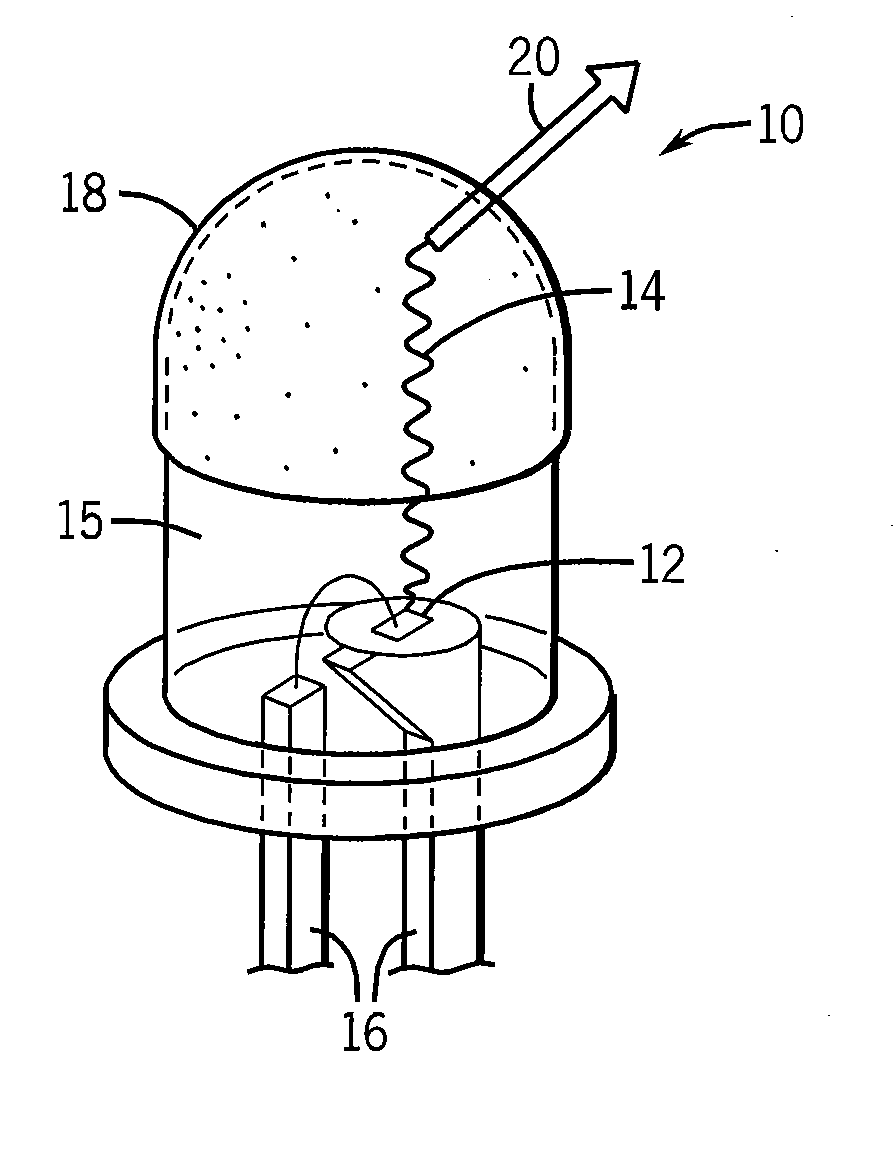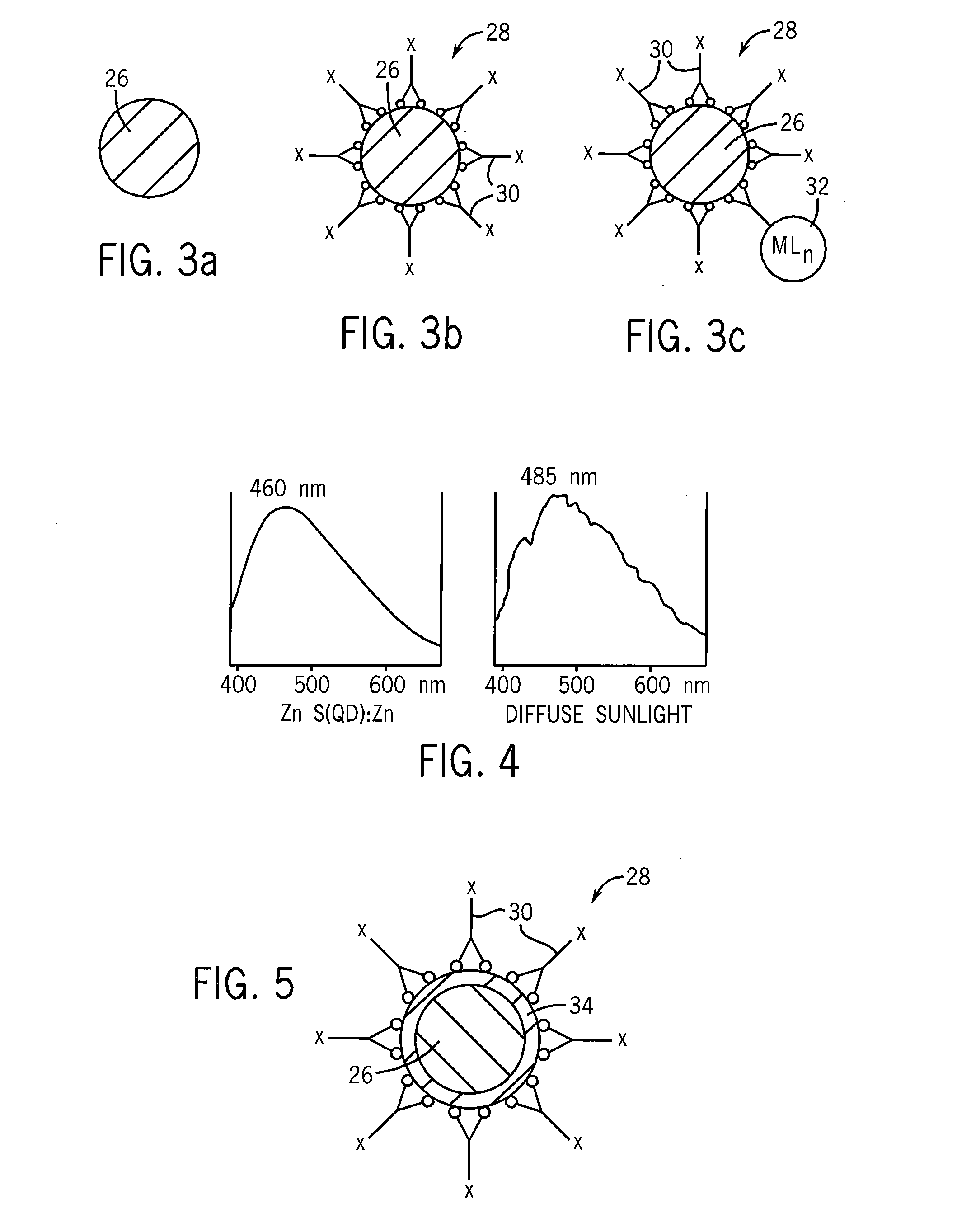Quantum dot phosphors for solid-state lighting devices
a technology of solid-state lighting and quantum dots, which is applied in the direction of fluorescence/phosphorescence, discharge tube luminescnet screens, instruments, etc., can solve the problems of phosphors using relatively expensive or highly toxic materials, light does not match the continuous spectrum normally associated with white light, and limit their popularity
- Summary
- Abstract
- Description
- Claims
- Application Information
AI Technical Summary
Benefits of technology
Problems solved by technology
Method used
Image
Examples
example i
[0035](I) Precursor A
[0036]ZnS / MSA (Core / Shell) Particles
[0037]A 1 L flask was charged with 24.0 g (80 mmol) Zn(NO3)2.6H2O, 300 mL of deionized water, and a large magnetic stir bar was added. The mixture was stirred to dissolve the zinc salt giving a slightly cloudy solution. To this was added, with stirring, 180 mL of concentrated aqueous ammonia. This immediately resulted in the formation of a suspension of an opaque white material, which subsequently dissolved after stirring for several minutes. The product was a clear colorless solution containing the Zn(NH3)42+ complex ion.
[0038]24 mL (77 mmol) of an aqueous (NH4)2S solution was added in a dropwise fashion to the rapidly stirred Zn(NH3)42+ complex ion solution. This resulted in the formation of an opaque white suspension of nanoscale ZnS. The ZnS suspension was then treated with a solution of 2.0 g mercaptosuccinic acid (MSA, 13.4 mmol) dissolved in 100 mL of deionized water. The suspension was aged for one hour and then transf...
example ii
[0043](I) Precursor A
[0044]Precursor A was prepared as described above.
[0045](II) Phosphor from A
[0046]ZnS / MSA:ZrOCl2 (Core / Shell:Activator) Phosphor
[0047]100 mg of the ZnS / MSA product was placed in a test tube. 10 mL of 0.01 M aqueous ZrOCl2 was added, the reagents were stirred for several minutes, and then allowed to age for 12 hours. The solid product was separated by centrifugation and careful decantation of the supernatant. The product was purified by repeated cycles consisting of: (a) addition of fresh water; (b) resuspension of the solids; (c) centrifugation of the suspension; and (d) careful decantation of the supernatant. After the final purification cycle, the last traces of water were removed from the solids by heating in an oven at 70° C. The product was a ZnS / MSA:ZrOCl2 phosphor that emitted broad-spectrum yellowish light when irradiated at 365 nm.
example iii
[0048](I) Precursor A
[0049]Precursor A was prepared as described above.
[0050](II) Phosphor from A
[0051]ZnS / MSA:Gd (Core / Shell:Activator) Phosphor
[0052]105 mg of the ZnS / MSA product was placed in a test tube. 10 mL of 0.01 M aqueous Gd(NO3)3.6H2O was added, the reagents were stirred for several minutes, and then allowed to age for 12 hours. The solid product was separated by centrifugation and careful decantation of the supernatant. The product was purified by repeated cycles consisting of: (a) addition of fresh water; (b) resuspension of the solids; (c) centrifugation of the suspension; and (d) careful decantation of the supernatant. After the final purification cycle, the last traces of water were removed from the solids by briefly heating in an oven at 100° C. The product was a ZnS / MSA:Gd phosphor that emitted yellowish-white broad-spectrum light when irradiated at 365 nm.
PUM
| Property | Measurement | Unit |
|---|---|---|
| diameter | aaaaa | aaaaa |
| wavelength range | aaaaa | aaaaa |
| wavelength range | aaaaa | aaaaa |
Abstract
Description
Claims
Application Information
 Login to View More
Login to View More - R&D
- Intellectual Property
- Life Sciences
- Materials
- Tech Scout
- Unparalleled Data Quality
- Higher Quality Content
- 60% Fewer Hallucinations
Browse by: Latest US Patents, China's latest patents, Technical Efficacy Thesaurus, Application Domain, Technology Topic, Popular Technical Reports.
© 2025 PatSnap. All rights reserved.Legal|Privacy policy|Modern Slavery Act Transparency Statement|Sitemap|About US| Contact US: help@patsnap.com



